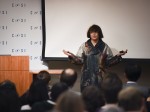A Harvard Professor said everyone has implicit biases they may not even realize at an event Saturday.
Mahzarin Banaji, a professor and administrative chair at Harvard University, spoke at the California Nanosystems Institute at UCLA regarding how implicit biases affect the way society thinks and the implications it has on those that society is biased against.
Banaji told the audience about a study in which resumes with the same qualifications were sent out under different names. She said that the study found people with particular last names were hired over others simply because they had last names that came from important families.
People often want to help others when they have things in common with them, Banaji said. She showed the audience an image of the brain with two areas highlighted. Banaji said that when people talk to those with similar political positions, the part of the brain that lights up when the person thinks of themselves becomes activated. However, when they interact with people with different political positions, a different part of the brain is activated. Banaji said this difference in brain activity is subconscious.
Banaji, who attended Yale University, admitted an incident in which she expressed her own implicit bias. When a reporter mentioned that she attended Yale as well, Banaji agreed to continue an interview she had originally intended to shut down.
Rahul Roy, an associate professor of physics and astronomy at UCLA, said one thing that stood out to him was when Banaji pointed out that implicit biases affect who people are willing to help out. He said this bias affects how people at UCLA decide to help others, such as when people choose whether to admit a prospective applicant or write a letter of recommendation.
Banaji led an implicit association test to reveal to the audience their own implicit biases. She asked people to say “left” when they saw the name of something they associated with a male or a career and “right” when they saw the name of something they associated with a female or home. Banaji then asked the audience to say “left” for names for females or careers and “right” for names for males or home. It took the audience about 50 percent longer to answer the prompts in the second test to answer those the first, demonstrating that people are more likely to associate males with careers and females with the home.
John Lassetter, a fourth-year physics student, took an IAT and said he had not thought of implicit bias prior to taking the test.
“One thing I thought was helpful was the advice she gave on how to reduce one’s bias,” he said. “One way is to consume media that shows people in counter stereotypical roles.”
Banaji said that the audience cannot expect to eliminate their biases right after the lecture, just as they cannot expect to lose weight right after a lecture on nutrition and weight loss.
“At the end of the lecture, would you have lost weight?” Banjo asked.
Rather, people should continue working to identify and resolve their biases after the lecture, just as they would hop on a treadmill to work toward weight loss.
